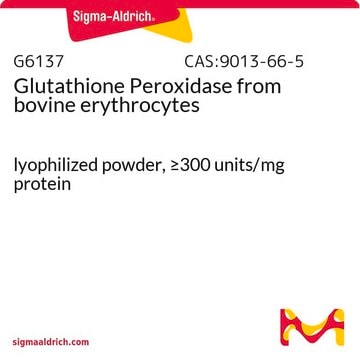G4013
Glutathione Peroxidase from human erythrocytes
lyophilized powder, ≥30 units/mg protein
Sinonimo/i:
GSH-Px, Glutathione:hydrogen-peroxide oxido-reductase
Autenticatiper visualizzare i prezzi riservati alla tua organizzazione & contrattuali
About This Item
Numero CAS:
Numero MDL:
Codice UNSPSC:
12352204
Prodotti consigliati
Forma fisica
lyophilized powder
Attività specifica
≥30 units/mg protein
Composizione
Protein, 13-25% modified Warburg-Christian
N° accesso UniProt
Condizioni di spedizione
dry ice
Temperatura di conservazione
−20°C
Informazioni sul gene
human ... GPX1(2876)
Descrizione generale
GPX1 (glutathione peroxidase 1) belongs to the four membered family of GPXs, including GPX2, GPX3 and GPX4. It is a selenocysteine-containing protein. GPX1 is the major isoform of GPX enzyme and is ubiquitously present intracellularly.
Note: At the reported pH optimum of 8.8, we have found the activity to be approx. 10 times that at pH 7.0. However, to remain consistent with literature and avoid complications arising from non-enzymatic oxidation of GSH, our unit is defined at pH 7.0.
Applicazioni
Glutathione peroxidase (GPX) from human erythrocytes has been used for the determination of the ability of peroxides to inactivate GPX in epithelial sheets obtained from cutaneous squamous cell carcinoma (CSCC) or solar keratoses (SK).
Azioni biochim/fisiol
GPX1 (glutathione peroxidase 1) catalyzes the conversion of multiple organic and inorganic peroxides, by utilizing reduced glutathione (GSH) as an electron donor. This enzyme is also responsible for the removal of organic and inorganic peroxides.
Definizione di unità
One unit will catalyze the oxidation by H2O2 of 1.0 μmole of reduced glutathione to oxidized glutathione per min at pH 7.0 at 25 °C.
Stato fisico
Lyophilized powder containing 25% sucrose, 3% dithiothreitol, and sodium phosphate buffer salts
Avvertenze
Danger
Indicazioni di pericolo
Consigli di prudenza
Classi di pericolo
Resp. Sens. 1
Codice della classe di stoccaggio
11 - Combustible Solids
Classe di pericolosità dell'acqua (WGK)
WGK 3
Punto d’infiammabilità (°F)
Not applicable
Punto d’infiammabilità (°C)
Not applicable
Certificati d'analisi (COA)
Cerca il Certificati d'analisi (COA) digitando il numero di lotto/batch corrispondente. I numeri di lotto o di batch sono stampati sull'etichetta dei prodotti dopo la parola ‘Lotto’ o ‘Batch’.
Possiedi già questo prodotto?
I documenti relativi ai prodotti acquistati recentemente sono disponibili nell’Archivio dei documenti.
O L Gostukhina et al.
Zhurnal evoliutsionnoi biokhimii i fiziologii, 48(6), 542-547 (2013-02-14)
The work studied the content of carotinoids, the state of antioxidant (AO) enzymatic complex, and intensity of lipid peroxidation in tissues (hepatopancreas, gill, foot) of the Black Sea bivalve mollusc Anadara inaequivalvis. Tissues with a high content of the pigment
Hai-Dong Yao et al.
The Journal of nutrition, 143(5), 613-619 (2013-03-22)
Dietary selenium (Se) deficiency causes muscular dystrophy in various species, but the molecular mechanism remains unclear. Our objectives were to investigate: 1) if dietary Se deficiency induced different amounts of oxidative stress, lipid peroxidation, and cell apoptosis in 3 skeletal
Bing-Lin Zhang et al.
Environmental toxicology and chemistry, 32(6), 1420-1425 (2013-02-19)
The effect of sodium chloride (NaCl) on cadmium (Cd) uptake, translocation, and oxidative stress was investigated using 2 tobacco cultivars differing in Cd tolerance. The growth inhibition of the tobacco plants exposed to Cd toxicity was in part alleviated by
V A Makarchuk et al.
Ukrains'kyi biokhimichnyi zhurnal (1999 ), 85(1), 71-78 (2013-03-29)
In experiment on laboratory rats the models of acute and chronic pancreatitis were developed to study the changes of lipoperoxidation-antioxidant protection system depending on morphological changes of the pancreas. The acute and chronic pancreatitis is accompanied with intensification of lipoperoxidation
Jennifer Walshe et al.
Cancer research, 67(10), 4751-4758 (2007-05-19)
Cutaneous squamous cell carcinomas (CSCC) are a common malignancy of keratinocytes that arise in sites of the skin exposed to excessive UV radiation. In the present study, we show that human SCC cell lines, preneoplastic solar keratoses (SK), and CSCC
Il team dei nostri ricercatori vanta grande esperienza in tutte le aree della ricerca quali Life Science, scienza dei materiali, sintesi chimica, cromatografia, discipline analitiche, ecc..
Contatta l'Assistenza Tecnica.








